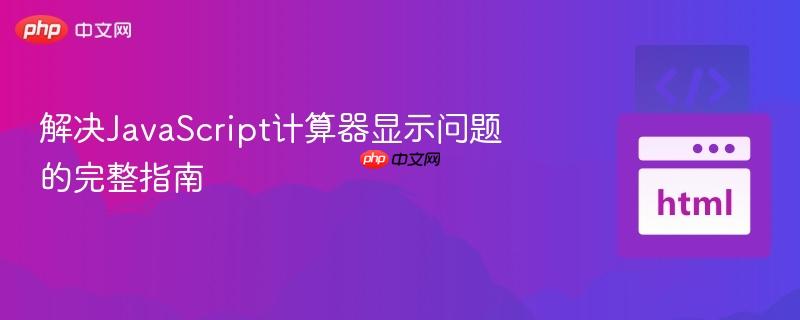
本文针对JavaScript计算器中数值不显示的问题,深入分析了其核心原因:`this.currentOperand`未初始化。教程详细介绍了在构造函数中通过调用`this.clear()`进行初始化的解决方案,并进一步修正了`updateDisplay`函数的显示逻辑以及`compute`函数中的计算错误。通过这些改进,确保计算器能够正确捕获、处理并显示用户输入及计算结果,提升代码健壮性和用户体验。
在开发基于JavaScript的简单计算器时,开发者常会遇到一个常见问题:点击数字按钮后,预期数值未能正确显示在屏幕上。这通常是由于计算器内部状态管理不当,特别是关键变量未被正确初始化所致。本教程将针对一个具体的JavaScript计算器代码示例,详细分析导致显示异常的原因,并提供一套完整的解决方案,包括初始化修正、显示逻辑优化及计算逻辑错误修复,旨在帮助开发者构建功能完善且用户友好的计算器应用。
原始代码中,当用户点击数字按钮时,appendNumber 函数被调用,它尝试执行 this.currentOperand = this.currentOperand.toString() + number.toString()。然而,如果 this.currentOperand 在此之前从未被赋值,它将是 undefined。尝试对 undefined 调用 toString() 方法会导致运行时错误,从而阻止数值的正确显示。
根本原因在于: Calculator 类的构造函数 constructor() 中,this.currentOperand 和 this.previousOperand 并没有被初始化。尽管存在 clear() 方法用于重置这些值,但它在对象实例化时并未被调用。
立即学习“Java免费学习笔记(深入)”;
最直接的解决方案是在 Calculator 类的构造函数中调用 this.clear() 方法。这样,每当创建一个新的 Calculator 实例时,currentOperand 和 previousOperand 都会被初始化为空字符串,避免了 undefined 错误。
修正后的 Calculator 构造函数:
class Calculator {
constructor(previousOperandTextElement, currentOperandTextElement) {
this.previousOperandTextElement = previousOperandTextElement;
this.currentOperandTextElement = currentOperandTextElement;
this.clear(); // 关键修正:在构造函数中调用 clear() 初始化状态
}
clear() {
this.currentOperand = '';
this.previousOperand = '';
this.operation = undefined;
}
// ... 其他方法保持不变
}除了初始化问题,原始代码的 updateDisplay() 函数也存在一些逻辑缺陷,导致显示不完全或不准确。具体来说:
修正后的 updateDisplay() 函数:
updateDisplay() {
// 确保当前操作数使用 getDisplayNumber 进行格式化并显示
this.currentOperandTextElement.innerText = this.getDisplayNumber(this.currentOperand);
if (this.operation != null) {
// 确保前一个操作数也使用 getDisplayNumber 进行格式化,并与操作符一同显示
this.previousOperandTextElement.innerText = `${this.getDisplayNumber(this.previousOperand)} ${this.operation}`;
} else {
// 没有操作符时,清空前一个操作数的显示
this.previousOperandTextElement.innerText = '';
}
}通过上述修改,getDisplayNumber 函数的格式化能力将得到充分利用,确保所有显示的数字都符合预期的本地化格式,并且前一个操作数和当前操作数能够正确地在各自的显示区域呈现。
在 compute() 函数中,原始代码存在一个严重的逻辑错误:所有运算符(+, -, *, ÷)的 switch 语句分支都执行了 computation = prev + current。这意味着无论用户选择何种运算,计算器都只会执行加法。
修正后的 compute() 函数:
compute() {
let computation;
const prev = parseFloat(this.previousOperand);
const current = parseFloat(this.currentOperand);
// 如果前一个或当前操作数无效,则直接返回
if (isNaN(prev) || isNaN(current)) return;
switch (this.operation) {
case '+':
computation = prev + current;
break;
case '-':
computation = prev - current; // 修正为减法
break;
case '*':
computation = prev * current; // 修正为乘法
break;
case '÷':
// 增加除数为零的错误处理
if (current === 0) {
alert("错误:除数不能为零!"); // 提示用户
this.clear(); // 清空计算器状态
return;
}
computation = prev / current; // 修正为除法
break;
default:
return; // 未知操作符,不执行计算
}
this.currentOperand = computation;
this.operation = undefined;
this.previousOperand = '';
}此修正确保了 compute() 函数能够根据选择的运算符执行正确的数学运算。同时,为 ÷ 操作符增加了除数为零的错误处理,提升了计算器的健壮性和用户体验。
为了清晰展示所有修正,以下是 Calculator 类中涉及修改的关键代码片段:
class Calculator {
constructor(previousOperandTextElement, currentOperandTextElement) {
this.previousOperandTextElement = previousOperandTextElement;
this.currentOperandTextElement = currentOperandTextElement;
this.clear(); // 修正1: 初始化状态
}
clear() {
this.currentOperand = '';
this.previousOperand = '';
this.operation = undefined;
}
delete() {
this.currentOperand = this.currentOperand.toString().slice(0, -1);
}
appendNumber(number) {
if (number === '.' && this.currentOperand.includes('.')) return;
this.currentOperand = this.currentOperand.toString() + number.toString();
}
chooseOperation(operation) {
if (this.currentOperand === '') return;
if (this.previousOperand !== '') {
this.compute();
}
this.operation = operation;
this.previousOperand = this.currentOperand;
this.currentOperand = '';
}
compute() {
let computation;
const prev = parseFloat(this.previousOperand);
const current = parseFloat(this.currentOperand);
if (isNaN(prev) || isNaN(current)) return;
switch (this.operation) {
case '+':
computation = prev + current;
break;
case '-':
computation = prev - current; // 修正3: 减法
break;
case '*':
computation = prev * current; // 修正3: 乘法
break;
case '÷':
if (current === 0) { // 修正3: 除零处理
alert("错误:除数不能为零!");
this.clear();
return;
}
computation = prev / current; // 修正3: 除法
break;
default:
return;
}
this.currentOperand = computation;
this.operation = undefined;
this.previousOperand = '';
}
getDisplayNumber(number) {
const stringNumber = number.toString();
const integerDigits = parseFloat(stringNumber.split('.')[0]);
const decimalDigits = stringNumber.split('.')[1];
let integerDisplay;
if (isNaN(integerDigits)) {
integerDisplay = '';
} else {
integerDisplay = integerDigits.toLocaleString('en', {
maximumFractionDigits: 0
});
}
if (decimalDigits != null) {
return `${integerDisplay}.${decimalDigits}`;
} else {
return integerDisplay;
}
}
updateDisplay() {
// 修正2: 正确使用 getDisplayNumber 格式化当前操作数
this.currentOperandTextElement.innerText = this.getDisplayNumber(this.currentOperand);
if (this.operation != null) {
// 修正2: 正确格式化并显示前一个操作数和操作符
this.previousOperandTextElement.innerText = `${this.getDisplayNumber(this.previousOperand)} ${this.operation}`;
} else {
this.previousOperandTextElement.innerText = '';
}
}
}
// 事件监听部分保持不变
const numberButtons = document.querySelectorAll('[data-number]');
const operationButtons = document.querySelectorAll('[data-operation]');
const equalsButton = document.querySelector('[data-equals]');
const deleteButton = document.querySelector('[data-delete]');
const allClearButton = document.querySelector('[data-all-clear]');
const previousOperandTextElement = document.querySelector('[data-previous-operand]');
const currentOperandTextElement = document.querySelector('[data-current-operand]');
const calculator = new Calculator(previousOperandTextElement, currentOperandTextElement);
numberButtons.forEach(button => {
button.addEventListener('click', () => {
calculator.appendNumber(button.innerText);
calculator.updateDisplay();
});
});
operationButtons.forEach(button => {
button.addEventListener('click', () => {
calculator.chooseOperation(button.innerText);
calculator.updateDisplay();
});
});
equalsButton.addEventListener('click', button => {
calculator.compute();
calculator.updateDisplay();
});
allClearButton.addEventListener('click', button => {
calculator.clear();
calculator.updateDisplay();
});
deleteButton.addEventListener('click', button => {
calculator.delete();
calculator.updateDisplay();
});通过上述步骤,您的JavaScript计算器将能够正确地捕获用户输入,执行精确的计算,并将结果清晰地显示在界面上,从而提供一个功能完善且用户体验良好的计算工具。
以上就是解决JavaScript计算器显示问题的完整指南的详细内容,更多请关注php中文网其它相关文章!

每个人都需要一台速度更快、更稳定的 PC。随着时间的推移,垃圾文件、旧注册表数据和不必要的后台进程会占用资源并降低性能。幸运的是,许多工具可以让 Windows 保持平稳运行。




Copyright 2014-2025 https://www.php.cn/ All Rights Reserved | php.cn | 湘ICP备2023035733号